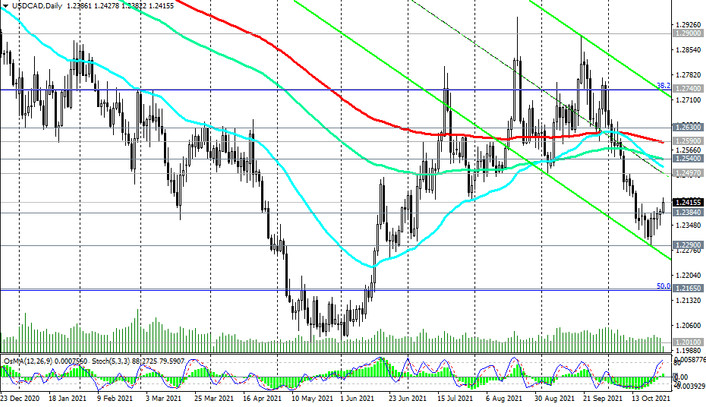This week, 3 of the world's largest central banks are holding their regular meetings on monetary policy issues. One of them is the Bank of Canada. Its meeting will end today with the publication (at 14:00 GMT) of the decision on the interest rate. Recently, there have been rather weak macro data from Canada, and many economists have lowered their forecast for the growth of the Canadian economy in 2021.
Thus, according to data published by the National Bureau of Statistics, Canada's GDP in the 2nd quarter fell by 1.1% (on an annualized basis), while economists predicted its growth by 2.5%.
At the same time, unemployment in the country still exceeds pre-pandemic levels (below 6%). In September, for example, it was 6.9%, and in August 7.1%. All these are negative factors for the Canadian economy and CAD quotes.
At the same time, according to data released last week by the National Bureau of Statistics of Canada, annual inflation in the country in September accelerated to its highest since 2003. The consumer price index rose 4.4% in September (on an annualized basis) after rising 4.1% in May, which is higher than the forecast of +4.3%. The annual increase in prices was the highest since February 2003. The average value of the preferred core inflation indicators by the Bank of Canada in September was 2.67%, which is the highest since December 2008. The core CPI, which does not take into account volatile food and energy prices, rose by +3.7% in September (in annual terms). If we take into account the significantly increased prices for energy resources, including oil, Canada's main export product, then real inflation could be significantly higher than 4.4%, while the target inflation rate for the Bank of Canada is in the range of 1% -3%. The rise in CPI is a harbinger of a rate hike and a positive factor for CAD.
However, it is widely expected that the Bank of Canada will keep its interest rate at 0.25% at its meeting today. In an accompanying statement, the central bank of Canada will explain the decision. The harsh tone of the accompanying statement by the Bank of Canada on rising inflation and the prospects for further tightening of monetary policy will cause the Canadian dollar to strengthen. If the Bank of Canada signals the need for soft monetary policy, the Canadian currency will decline.
During the press conference, which starts at 15:00 (GMT), the head of the Bank of Canada Tiff Macklem will explain the bank's position and assess the current economic situation in the country. If Macklem also speaks for maintaining a soft monetary policy, the Canadian currency will decline. In any case, high volatility in CAD quotes is expected during the period of his speech. Macklem may also announce the termination or reduction of the volume of purchases of bonds by the central bank and the decision to start raising rates in 2022 (some economists expect this by July 2020).
If such statements really follow from the leadership of the Bank of Canada, then the Canadian dollar, which receives significant support from rising oil prices (Canada is the largest exporter of oil, and the share of oil and oil products in Canada's exports is about 22%), updated this week 3-years highs near $ 84.90 for WTI and $ 85.75 for Brent, may strengthen significantly, including in the USD / CAD pair.
Meanwhile, the US dollar is strengthening and the DXY dollar index is rising for the third day in a row today. As of this writing, DXY futures are traded near 93.97, 50 pips above the local low of 93.47 reached late last week.
Market participants assess the prospects for the Fed's monetary policy, which will remain soft even if, at a meeting on November 2-3, the leaders of the American central bank decide to reduce the volume of purchases on the bond market, which is currently $ 120 billion a month. At the same time, the Fed's interest rates will remain at current levels for at least a few more months. According to previously published minutes of the Fed's meeting on September 21 and 22, only half of the 18 leaders expect that interest rates will need to be raised by the end of 2022, and almost all leaders anticipate another rate hike in 2023.
Thus, despite the expected reduction in the volume of the stimulus program, the Fed's monetary policy remains soft, which is a negative factor for the dollar.
Nevertheless, the US dollar is gaining support, remaining a defensive asset amid the continuing rise in COVID-19 infections.
Market participants will now carefully study the incoming macro statistics from the United States, especially regarding inflation and the state of the labor market, ahead of the November meeting of the FRS, in order to more accurately determine its intentions regarding the prospects for monetary policy.
In this regard, market participants today will follow the publication (at 12:30 GMT) of data on orders for durable goods and orders for capital goods (excluding defense and aviation). This indicator reflects the value of orders received by manufacturers of durable goods and capital goods (capital goods are durable goods used to produce durable goods and services), implying large investments. Previous values of the indicator "orders for durable goods": +1.8% in August, -0.1% in July, +0.9% in June, +2.3% in May, -1.3% in April, +1% in March, -1.2% in February, +3.4% in January 2021.
Previous values of the indicator "orders for capital goods excluding defense and aviation": +0.6% in August, 0% in July, +0.7% in June, +0.1% in May, +2.2% in April, +1% in March, -0.9% in February, +0.6% in January 2021.
The relative growth of the indicator usually has a positive effect on the dollar, while the decline in the indicator is negative. Data worse than the previous value and / or forecast will negatively affect the dollar quotes.
Forecast for September: -1.1% (orders for durable goods), +0.5% (orders for capital goods excluding defense and aviation). It looks like the growth of indicators has slowed after their recovery in previous months from a strong drop in March and April 2020, which should negatively affect the dollar quotes. Better-than-expected data will have a positive impact on the dollar in the short term.
In general, the downward dynamics of the USD / CAD pair remains, which at the time of publication of the article is traded near the mark of 1.2415, in the zone below the key resistance levels 1.2525, 1.2590, 1.2900 (see Technical analysis and trading recommendations).






